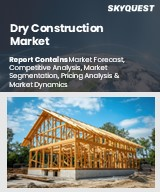
세계의 건식 공법 시장 규모는 2023년에 852억 달러, 2024년 892억 달러에서 2032년에는 1,288억 1,000만 달러로 성장하고, 예측 기간(2025-2032년) CAGR은 4.7%를 보일 전망입니다.
세계 건식 공법 시장은 더 빠르고 친환경적인 건축 솔루션에 대한 소비자 수요, 정부의 이니셔티브, 기술 혁신에 힘입어 강력한 성장을 거듭하고 있습니다. 도시화가 가속화됨에 따라 각국 정부는 지속 가능한 인프라와 친환경 소재의 채택을 우선시하는 스마트 시티 프레임워크를 지지하고 있습니다. 예를 들어, 싱가포르의 강력한 인프라 프로그램은 모듈식 및 조립식 건설 방식을 옹호하며, 환경에 미치는 영향을 최소화하면서 현장 노동력과 프로젝트 기간을 단축하는 경량 구성 요소에 인센티브를 부여하고 있습니다. 민관 파트너십을 기반으로 한 이러한 노력은 2025년까지 지역 개발 목표를 달성하기 위해 매우 중요합니다. 또한, AI를 활용한 프로젝트 관리, 3D 프린팅, 자동 조립식 등의 발전은 건설 정확도와 생산성을 향상시키고, 궁극적으로 건식 공법 분야의 새로운 트렌드를 형성하여 효율적인 계획, 폐기물 감소, 안전성 향상을 촉진할 것입니다.
Global Dry Construction Market size was valued at USD 85.2 billion in 2023 and is poised to grow from USD 89.2 billion in 2024 to USD 128.81 billion by 2032, growing at a CAGR of 4.7% during the forecast period (2025-2032).
The global dry construction market is witnessing robust growth driven by consumer demand for faster and more eco-friendly building solutions, government initiatives, and technological innovations. As urbanization accelerates, governments are endorsing smart city frameworks that prioritize sustainable infrastructure and the adoption of eco-friendly materials. For example, Singapore's robust infrastructure program advocates for modular and prefabricated construction methods, offering incentives for lightweight components that reduce onsite labor and project timelines while minimizing environmental impact. These efforts, bolstered by public-private partnerships, are crucial for achieving regional development goals by 2025. Additionally, advancements like AI-driven project management, 3D printing, and automated prefabrication are enhancing construction accuracy and productivity, ultimately shaping new trends in the dry construction sector, promoting efficient planning, reduced waste, and improved safety.
Top-down and bottom-up approaches were used to estimate and validate the size of the Global Dry Construction market and to estimate the size of various other dependent submarkets. The research methodology used to estimate the market size includes the following details: The key players in the market were identified through secondary research, and their market shares in the respective regions were determined through primary and secondary research. This entire procedure includes the study of the annual and financial reports of the top market players and extensive interviews for key insights from industry leaders such as CEOs, VPs, directors, and marketing executives. All percentage shares split, and breakdowns were determined using secondary sources and verified through Primary sources. All possible parameters that affect the markets covered in this research study have been accounted for, viewed in extensive detail, verified through primary research, and analyzed to get the final quantitative and qualitative data.
Global Dry Construction Market Segments Analysis
Global Dry Construction Market is segmented by Type, Material, System, Application and region. Based on Type, the market is segmented into Supporting Framework and Boarding. Based on Material, the market is segmented into Plasterboard, Wood, Metal, Plastic and Others. Based on System, the market is segmented into Ceiling System, Wall System, Flooring System and Others. Based on Application, the market is segmented into Residential Application and Non-Residential Application. Based on region, the market is segmented into North America, Europe, Asia Pacific, Latin America and Middle East & Africa.
Driver of the Global Dry Construction Market
The growth of urbanization and increased infrastructure investments in regions such as the Middle East, Africa, Asia Pacific, and Latin America are significant drivers for the Global Dry Construction market. Governments in these areas are promoting dry construction methods and modular building techniques to enhance project speed and reduce dependence on onsite labor. These innovative approaches are gaining traction across various sectors, including commercial infrastructure, affordable housing, and smart city initiatives. This shift is not only accelerating market adoption but also fostering a positive outlook for the industry in these dynamic regions.
Restraints in the Global Dry Construction Market
The Global Dry Construction market faces certain limitations primarily related to initial material costs. Although dry construction techniques offer long-term savings, the upfront expenses for materials like metal frames, prefabricated systems, and high-performance gypsum boards can be significantly higher than traditional methods. This financial barrier may deter adoption in cost-sensitive regions or among smaller construction firms. Consequently, these factors contribute to a sluggish dry construction market in certain developing areas, ultimately hindering the overall growth and expansion of the industry on a global scale. Addressing these cost challenges is essential to enhance market penetration and accessibility.
Market Trends of the Global Dry Construction Market
The Global Dry Construction market is witnessing a significant trend towards the integration of Building Information Modeling (BIM), enhancing the efficiency and effectiveness of construction processes. BIM's capabilities allow for seamless design collaboration, meticulous construction planning, and comprehensive lifecycle management, revolutionizing traditional methodologies. This integration facilitates conflict detection, virtual construction simulations, and optimal coordination of prefabricated components, leading to reduced project timelines and enhanced quality control. As stakeholders increasingly recognize the benefits of digital representation and streamlined communication throughout the project lifecycle, the demand for BIM-integrated dry construction solutions is poised to grow, positioning the market for robust expansion in the coming years.